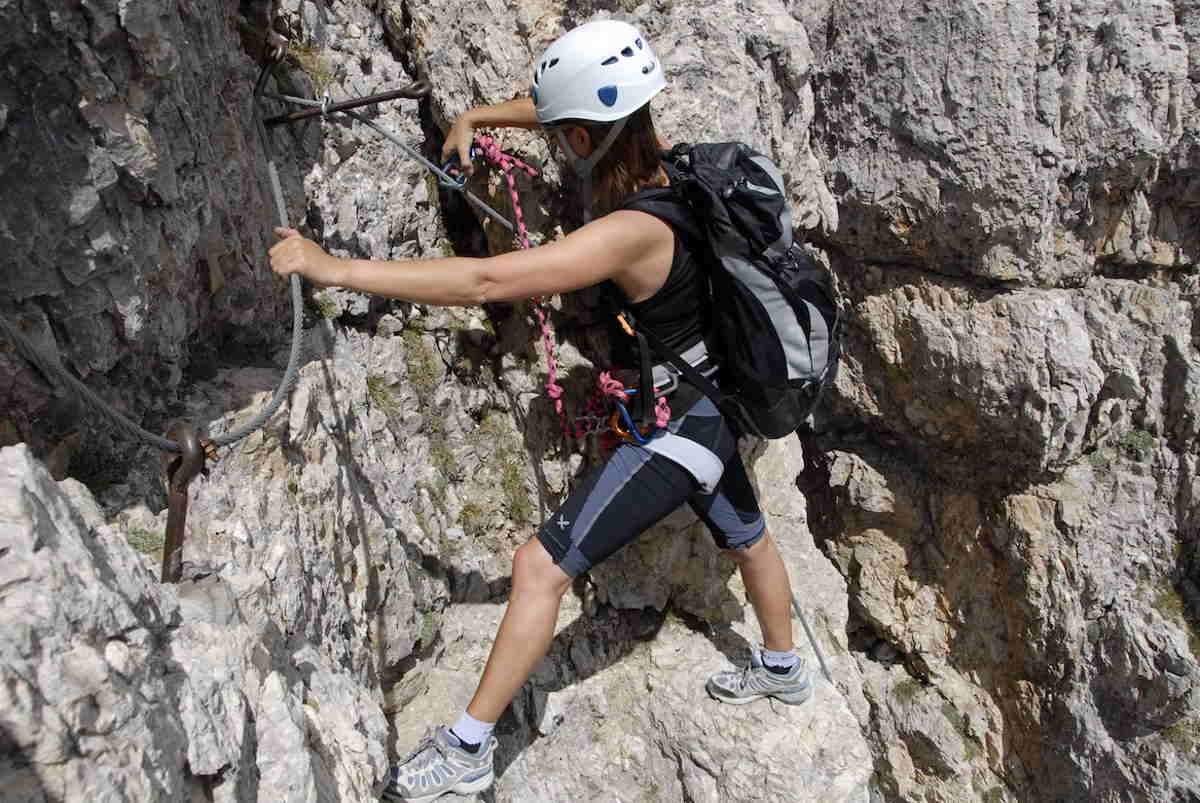If you have a fear of heights, you may find that stress and panic can set in even on stable ground. Climbing, therefore, can be a particularly terrifying prospect. In certain areas, however, you may find a protected route known as a via ferrata. With fixed rungs, ladders, bridges and wires, they are often viewed as less technically challenging than ‘traditional’ rock climbing. Despite this, they can still prove frightening for those of us with acrophobia.
In this guide, we’ll explain a little bit more about what a via ferrata is and take a look at whether people with acrophobia can climb one. We’ll also cover the safety precautions you can take to help keep fear at bay on the mountains.
What is a via ferrata?
Via ferrata is an Italian-language term meaning iron path. It refers to a type of climbing route that makes use of metal rungs, rails and other similar anchors that are fixed into the face of a mountain. Despite the name, via ferratas are not always made of iron; steel is commonly used, while parts of the route may even be wooden.
You’re perhaps most likely to come across a via ferrata in the Alps. They’re often associated with Italy’s Dolomites, where many such routes were constructed during the First World War to help troops traverse the mountains. Hundreds of routes can be found in the country today, as well as in neighbouring Austria, France, Germany and Switzerland.
Elsewhere, via ferratas took somewhat longer to catch on, but are increasing in popularity, and can now be found in destinations as far-flung as China, New Zealand and the UAE. Another notable example is the route up to the Skylodge in Peru.
Via ferrata vs rock climbing

According to Austria’s Tyrol Tourism Board, via ferratas are “generally easier than traditional sport climbing routes”. That’s because the metal anchors embedded into the rock act as convenient footholds, making ascent less difficult. This contrasts with other forms of climbing: in sport climbing, permanent bolts may be used to prevent falls, but not to aid ascents, while in trad climbing, all protection must be added by the climbers themselves and removed afterwards.
Another difference between via ferratas and other types of rock climbing is the equipment required. There is naturally some overlap between the two activities, including the wearing of a helmet and harness. However, some of the specialised gear used for other climbing styles is not necessary here. Red Bull, for example, advises that a via ferrata can be completed in walking boots rather than climbing shoes. For more detail, check out our equipment section.
Is a via ferrata easy to climb?
As we’ve mentioned, via ferratas are typically considered as easier than some other mountain climbing routes. However, this doesn’t necessarily mean that they’re a walk in the park.
Different via ferratas can vary tremendously in terms of terrain, with a number of grading scales used to indicate difficulty levels. One of the most common of these is the Schall scale, which you can see below.
| Grade | Description |
|---|---|
| A (Easy) | Terrain mostly rocky, from flat to steep. Steady footing and a head for heights are recommended. |
| B (Moderately difficult) | Steep and rocky terrain. Via ferrata equipment is recommended, and some degree of power and endurance in one’s limbs is required. |
| C (Difficult) | Clamps and pins may be further apart, and the terrain can be very steep. Requires a greater degree of power and endurance, and via ferrata equipment is strongly recommended. |
| D (Very difficult) | Terrain is vertical and may be overhanging. Often consists of just a wire rope. Via ferrata equipment is obligatory, and climbers must have strength in their hands and arms. |
| E (Extremely difficult) | A higher level of physical condition is required, including strength in fingers, arms and legs. Slab climbing may be required. Clamps and pins are generally far apart, and climbers will need to scramble. |
| F or higher (More than extremely difficult) | Combined with scrambling on mostly overhanging terrain. Climbers must have good technique and a lot of strength. Top rope climbing equipment is recommended. |
Source: Alpine Trek
Some of the more difficult via ferratas, therefore, require greater strength, proper climbing technique, and the use of specialised equipment. However, the less challenging routes can be tackled by beginners with little difficulty—at least when it comes to the physical side of things.
However, climbers are recommended to have a good head for heights on even the easiest of via ferratas. If you have acrophobia, the process can be mentally much tougher.
Can you climb a via ferrata with a fear of heights?
For many, a via ferrata is simply a fun activity that rewards the climber with scenic views at the top. However, for people with acrophobia, vertigo and the fear of falling can dissuade you from even taking the first step. So, can those with a fear of heights climb a via ferrata?
The answer is that it all depends on the individual. For some, the safety afforded by a via ferrata’s secure metal wires and rungs makes it possible to climb mountains that would otherwise have been unthinkable.
One such example is Heidi Farrington, who was profiled in National Geographic. Despite her fear of heights, she stated that she felt “pretty darn safe” whilst on a via ferrata in West Virginia. She then went on to climb more frequently, and even took a trip to explore the via ferratas of Italy’s Dolomites.
Similarly, Joanna of OverHere.eu stated that she “used to be afraid of exposure and heights”, but got “completely hooked” after trying out a via ferrata. Though the route itself can “look scary and challenging”, this is outweighed by “positive emotions” and “breathtaking views”.
For others, though, acrophobia can put a dampener on the experience. After climbing a via ferrata in Kosovo, blogger Travelling Jackie wrote that “[her] fear held [her] back where it didn’t hold others back”. Though she was proud of having completed her climb, she felt that it was “not worth” the degree of fear, as well as physical and mental strength.
The reality is that only you will know if a via ferrata is right for you. If you feel comfortable, go for it—but don’t feel forced to do so if your fear is too great.
Via ferrata with a fear of heights: video
Interested in seeing someone with a fear of heights conquering a via ferrata? Check out the video below of Torbjørn Husevåg climbing in Loen, Norway.
Staying safe on a via ferrata
If you have acrophobia, it might not always be easy to remain calm while ascending a via ferrata. However, you can help yourself to feel more at ease by ensuring that you’re following all of the proper safety precautions. While these routes are safer, it is possible to seriously injure yourself if you fall or become tired on the route. In fact, in a study of Austrian via ferratas, exhaustion stood out as the top reason why people needed to be rescued.
Here are some of our top safety tips for climbing a via ferrata:
- Know your limits. If you’ve never climbed a via ferrata before, try one of the easier degrees of difficulty before tackling something more challenging. Be aware that it may not be possible to leave the route partway through if you get tired, so do your research before setting off.
- Don’t fall. This sounds obvious, but there’s a reason you may not have thought of: fall factor. Because of the safety equipment in place, you can fall much further from a via ferrata than is possible in other forms of climbing. This can seriously impact your body when you come to a stop. You may also end up hitting other objects on your way down.
- Avoid climbing in poor weather conditions. Metal rungs can easily become slippery when it rains, and in a thunderstorm, you could even run the risk of being hit by lightning.
- Be aware of potential rock fall. If you accidentally dislodge any rocks, shout a warning so that people below you can take cover. Should you hear such a warning yourself, pull close to the mountain face so that any debris hits your helmet and not your face.
- Have at least one carabiner hooked to the cable at all times. When moving past a pin, be sure to unclip and re-clip your carabiners one at a time. This ensures that you’ll stay attached to the wire.
- Always carry the right equipment. We’ll go into this in more detail below, but this means taking a via ferrata set with you, as well as a wearing suitable hiking boots and a climbing harness and helmet.
Equipment

It can be tempting to assume that a via ferrata requires the same equipment as any other form of rock climbing. However, there are some key differences. Let’s explore the gear you’ll need:
- Via ferrata set: a specialised lanyard, with two lengths of stretchy fabric each with a carabiner at the end. This is what allows you to clip onto the metal cable. It will also include a braking device that is able to absorb shocks should you fall.
- Harness: you can either opt for a sitting or full-body harness. Sitting harnesses are strapped around the waist and thighs, while full-body harnesses also include extra protection for the chest and shoulders. Guide Dolomiti recommends a sitting harness for a via ferrata.
- Helmet: opt for a climbing helmet. Some climbers wear bike helmets, but this is not recommended.
- Hiking boots: it’s not always necessary to wear specific climbing shoes, particularly on easier routes. However, if you’re attempting something more difficult, look into appropriate footwear.
- Gloves: if you’re new to a via ferrata, climbing metal rungs and rock face can be tough on your hands. You may therefore choose to wear gloves. Be sure to go for a pair with a rougher surface rather than smooth leather, which will offer less grip. More experienced climbers often forgo gloves, as their hands offer the best grip.
- Additional equipment, such as layers that you can put on or remove as the weather dictates; sunglasses; a water bottle; sunscreen.
Via ferrata with acrophobia
Climbing a via ferrata may not be an activity everyone enjoys, particularly if you have severe acrophobia, and you may find yourself adding some of the locations featured here to your list of destinations to avoid. However, for some people, this more secure approach to rock climbing provides a way of overcoming fear and enjoying mountainous landscapes like never before.
Planning on taking to the iron path yourself? We have a comprehensive guide covering what to do if you experience a fear of heights while climbing, including top tips for overcoming your fear. Plus, for more useful advice, check out the other articles in our Travel and Hobbies section, such as taking on the Three Peaks Challenge with a fear of heights.



